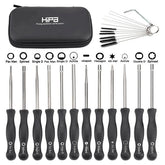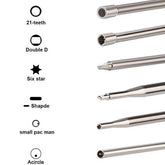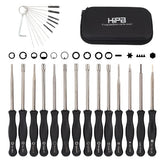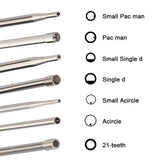Reasons and Solutions On the Chainsaw That Cuts Crooked
If your chainsaw tends to perform the crooked cutting every time you cut at a 90-degree angle. You may be confused about the cutting result, and have no idea how to address it. Fortunately, based on plenty of research and analysis, we have figured out the reasons and solutions to the crooked cutting that impacts negatively on your cutting. Go through the article, and we will help you save your chainsaw.
Reasons
A Badly Dull Chain
The first reason that breaks your cutting efficiency may come from the chainsaw chain itself. With the worn or even broken cutter teeth, the badly worn chain can not lead to a normal cutting path but a crooked one. So it is necessary to check your chain and sharpen it in time. If you have no idea how to sharpen your chain, you can take it through this blog for reference: File Sizes for Different Chainsaw Chains.
A Wrong Size Chain
Another reason also comes in the chainsaw chain itself. The wrong size chain, precisely a chain with a thicker gauge makes the chain stand unstable in the chain groove. It is really dangerous to cut with such a wrong size chain, because the chain naturally tends to lean on the groove, making the cutter teeth of the chain cut at an angle that differs from what you want. Therefore, it is important to check the gauge of the chain is the same as your guide bar. A simple way to check if your bar has a wrong gauge chain is to grab your chain on the guide bar and move it back and forth. If the chain flops over snugly, it shows you have the wrong gauge chain to work with. Then you’ll need to replace it with a right size chainsaw chain.
A Worn-Groove Bar
As we mentioned above, the chain will lean on the groove when cutting, and the groove will wear over time, which may result in the failure of the rails to support the chain to stand straightly. Even if you have the proper chain, the wider groove will also provide the space where the chain can sway.
A Worn-Rails Bar
The bar rails are the two edges besides the groove. It is can be seen that the rails always wear irregularly and unevenly, or one of the rails is taller than the other one, making the chain stand at a slope angle to start with. So you can not make a straight cutting with a worn-rails bar as your chain is not sitting straightly on the guide bar. The easiest way to check the rails’ level is to stand the guide bar up on a parallel surface. If the bar stands stably by itself, it indicates the rails are at the same level and just need a fine tune.
Solutions
If your guide bar is good, and the problem comes from your chain, there are two ways to make your chainsaw go back into service: one is to sharpen your dull chain; the other is to change your wrong size chain with a correct one.
For the worn-groove guide bar, you can grab the chain on the top of the guide bar and wiggle it, then repeat the move to the chain on the bottom of the guide bar. And, compared to the two wiggles extend, if the top chain wiggles are less than that of the bottom chain, you need to flip the guide bar over; if the chains on the two parts all have a big wiggle, you need to buy a new guide bar.
Apart from the worn groove guide bar, we also have three ways to save your cutting from the worn-rails guide bar. First, you can send your worn guide bar to a grinder at a local small engine shop around your home. Second, as an easy DIY solution, you can use a flat file to tune your guide bar rails to the same level with your hand and eyeballs. Third, a bar rail dresser is a more professional tool that helps to adjust your rails to a level mechanically.
Please let us know if this works and if you have any suggestions or comments. Or you can join us to feature your passion for repair projects, share your stories with the Hipa family and also get help from Hipa.






















